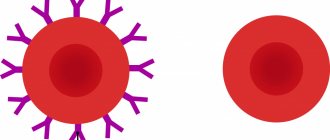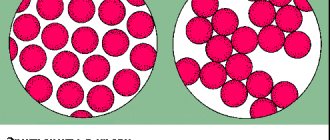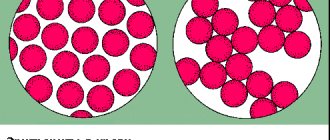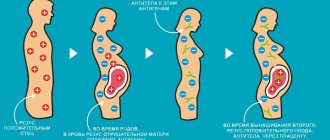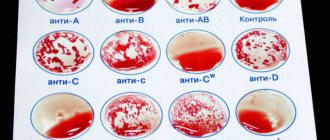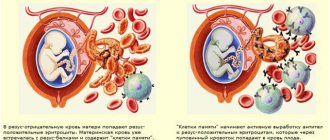When expecting the birth of an heir in the family, future parents wonder who he will take the height from, whether he will be born blond or brunette. But, perhaps, the main question is what blood type is and how the Rh factor is transmitted to the child. Some families will not pay attention to this. But its negative meaning in the future life of the baby can turn into a problem.
Therefore, the following issues need to be taken seriously:
- general concepts about the Rh factor;
- how it is formed;
- what does it depend on;
- How is the Rh factor inherited?
- about its danger during pregnancy of the expectant mother;
- how is a hereditary disease inherited with the Rh factor;
The importance of these issues is identified with the importance of other blood characteristics in general.
Preface about the Rh factor
The concepts of blood group and Rh factor have appeared recently. When mixing erythrocytes from different samples, the scientist Landsteiner K. in 1940 noticed that in some cases clots formed.
Based on this, when further studying the properties of red blood cells, he divided them into 2 groups, calling them A and B.
His students have already identified a group containing both A and B.
This is how the ABO system was born, which divides blood into groups as follows:
- if antigens A and B are absent, then this group is designated I (0), which corresponds to the first blood group;
- if only A antigens are present, then this is designated II (A) - this is the second group;
- if only B antigens are present, then this group is designated III (B) - third group;
- if antigens A and B are present, then this is IV (AB) - the fourth group;
Further research revealed that protein may be present on the surface of red blood cells. This property is called a positive Rh factor; if the protein is absent in the blood, then it is a negative Rh factor.
All this formed the basis of the so-called Rh classification system.
Thus, there are 4 types of blood groups: I, II, II, IV (or 0, A, B, AB) and two Rh factors: Rh(+) - positive and Rh(-) - negative.
People with negative Rh may be only 15% of the entire population.
The indicators of blood group and Rh factor are in no way related to each other, but when determining a blood group, they always talk about its Rh factor, for example, II Rh(+). These two values are equally important during blood transfusions and during pregnancy.
Rhesus must be inherited from parents, not change throughout a person’s life, and when asked whether hereditary diseases are transmitted with the Rh factor and whether it depends on its positive or negative value, we can say for sure that it is not.
Now geneticists are studying the properties of blood. They established that the inheritance of Rh factors and blood groups is subject to the laws of Mendel, discovered by him in the 19th century. From the school curriculum there are well-known experiments with peas that confirm this law. How the gene for its negative value is inherited in the Rh factor is very well explained by this law.
What blood type will the child have?
The topic for this article was suggested to us by our patients asking a question about their child’s blood type.
Very often this question is asked by young couples who want to have healthy children in order to find out about the possible risks in the presence of hereditary diseases, what the child’s blood type may be, and whether there is a possibility of developing an Rh conflict. In the international classification, it is these two indicators (blood type and Rh factor) that are most important. Every person needs to know their blood data in case of a possible emergency and the need for a donor blood transfusion, because not every blood is compatible. Blood type is an inherited trait that does not change throughout life. The most common system for dividing blood into groups is the AB0 system. Depending on the presence of certain proteins on the surface of red blood cells, called aglutinogens, and proteins found in the plasma - aglutinins, four blood groups are distinguished: 0 (zero) - first, A - second, B - third and AB - fourth. It is this system that is used to select blood during transfusion. However, having received the parental genes, the child, unexpectedly for the parents, may have a different blood type.
Division into blood groups
On what basis is human blood divided into four groups? In this case, the same genetic principles of inheritance, developed by Gregor Mendel back in 1866, apply. According to his theory, a person receives from each parent his own version of development for each characteristic: eye color, hair, nose shape, body type. One of them remains the main one - dominant, the second is suppressed and becomes recessive. But both exist in a person's genetic makeup, and either one can be inherited by a child.
It turns out that human red blood cells have special antigens on their surface, called A and B, and depending on how these genes are distributed and which one will dominate, the child’s blood type depends.
Inheritance of blood type from parents
According to recognized standards, blood groups are designated by a Roman numeral and the letter of the dominant antigen: I(0);
II(A); III(B); IV(AB). But, according to the laws of genetics, every person also has a recessive (suppressed) trait. It may be in the same literal expression as the dominant one, or it may be the opposite. For example: a person with the second blood group may have Aa antigens, where the first A is dominant, the second a is recessive. A may have Ab, where the first A is a dominant, determining his existing blood type, and b is a suppressed trait that does not manifest itself in any way.
But, it can be inherited and appear in the offspring if it encounters a recessive trait similar to itself. So what kind of blood inheritance will the future child receive?
It turns out that for heirs there are often several options for blood groups, and the greatest number of them are among those whose parents have the first or fourth blood group. The blood type of a child according to his parents is calculated by the laws of inheritance; according to the same laws, there are impossible options: - One of the partners has the fourth blood group, in this family a baby with the first group will never be born, regardless of the blood type of the second parent. - If, on the contrary, one of the parents has the first blood group, this family will never have children with the 4th blood group. However, exceptions are always possible. In 1952, a case was described when in an Indian family, where the parents had blood group IV, a child was born with blood group I. It turned out that the baby does not have the H antigen, the precursor of antigens A and B. This blood belongs to the first group, but in fact cannot be considered as such, since the H antigen is present in all four groups. Such blood can rather be classified as a phenomenon; such cases are quite rare. The bulk of them are residents of the Negroid race. There are other cases when the child’s blood type does not match the parents’, but this is a completely natural result of mixing the 2nd group and the 3rd. This is a unique variation in which children can have any blood type. The table clearly demonstrates the possible blood groups of a child.
Thus:
Parents with the first blood group can only have a child with the first group. Parents with the second have a child with the first or second. Parents with the third have a child with the first or third. Parents with the first and second have a child with the first or second. Parents with the first and third have a child with the first or third. Parents with the second and third have a child with any blood group. Parents with the first and fourth have a child with the second and third. Parents with the second and fourth have a child with the second, third and fourth. Parents with the third and fourth have a child with the second, third and fourth. Parents with the fourth have a child with the second, third and fourth. If one of the parents has the first blood group, the child cannot have the fourth. And vice versa - if one of the parents has a fourth, the child cannot have a first. Antigen B matures by the age of one year, so it is sometimes not detected at birth. As a result, a child with the third blood group may receive the first blood group at birth, while a child with the fourth may receive the second. By the age of one year, the antigen matures and the blood type changes.
Blood division system based on Rh factor
Another classification that is of utmost importance is the Rh factor. Blood rhesus is a protein compound found on the membranes of red blood cells. Its purpose in the body is not entirely clear, however, about 85% of the world's population has this protein as part of cell membranes. This population is called Rh-positive, those percentages that do not have it are, accordingly, Rh-negative.
A married couple, thinking about procreation, must definitely check the presence or, on the contrary, absence of this protein in each of the spouses. This is important, since a discrepancy between the maternal and fetal blood according to the Rh factor can lead to the death of the child. A woman’s immune system perceives the Rh protein of the unborn baby as an antigen that causes an allergic reaction and reacts to it by producing antibodies. Penetrating through the placental barrier, these antibodies cause destructive processes in the body of the developing fetus. However, all of the above is true for an Rh-negative mother and an Rh-positive baby. If the mother is Rh+ and the baby is Rh-, there is no conflict. Therefore, examination and blood test for Rh factor is mandatory for a pregnant woman. Rh protein is passed on to the child according to the same general rules of genetic inheritance. In most people, factor D (the presence of protein) is dominant, and factor d (its absence) is recessive.
Inheritance of Rh factor
· The most common situation is DD + DD, in this case there is no threat to pregnancy
· With the option DD + Dd, there will also be no problems from the Rh protein · The situation Dd + Dd is risky, but percentage-wise safer than the next one · Dd + dd, here a Rh conflict occurs in half of the cases. Whether a child will inherit the presence of Rh protein, and what blood type the child will have, depends on what genes the parents pass on to him. Moreover, both dominant and recessive genes play an important role.
In conclusion:
It would seem that everything has already been clarified, but questions always remain.
For example, can blood types change during life? There is no documentary data or official research on this topic. It is believed that blood is genetic material laid down at the beginning of intrauterine development, and its indicators are unchanged. However, there is evidence that some infectious diseases can cause changes in the general blood picture, which leads to the establishment of a false analysis. There is a temporary change in blood type. Similar cases of blood type changes are sometimes observed in pregnant women. What if the child's blood type does not match the parents? On this issue, it is best to consult a specialized doctor.
The most basic thing about the concept of blood group
The child's blood depends on the parents and is inherited with the so-called ABO gene, which is located on chromosome 9. The following table will show how likely it is that a group will be taken from its parents.
| Parents' blood types | Heritable blood type in a child as a percentage | ||||
| I | II | III | IV | ||
| I and I | 100% | — | — | — | — |
| I and II | 50% | 50% | — | — | |
| I and III | 50% | — | 50% | — | |
| I and IV | — | 50% | — | 50% | |
| II and II | 25% | 75% | — | — | |
| II and III | 25% | 25% | 25% | 25% | |
| II and IV | — | 50% | 25% | 25% | |
| III and III | 25% | — | 75% | — | |
| III and IV | — | 25% | 50% | 25% | |
| IV and IV | — | 25% | 25% | 50% | |
With 100 percent probability we can say which blood type will be passed on to the baby if they both have the first.
What can a child inherit?
The principles of transmission of hereditary characteristics from parents to children were formulated more than a century and a half ago by the Austrian biologist, monk Gregor Johann Mendel. Mendel's experiments were understood and recognized only half a century after his death. Thus, classical genetics appeared at the beginning of the 20th century, Dmitry Okunev, a therapist and senior medical consultant at the Teledoctor24 service, tells Izvestia.
“Despite this, today parents are still concerned about the same questions: who will the baby look like, why did he become the owner of wonderful curls or a square chin. At this point, it is appropriate to recall that brown eye color and the gap between the front teeth are caused by a dominant gene, and the gene for straight hair is recessive, explains the doctor.
Blood for blood
Photo: Depositphotos/Paha_L
Pathogenic engineering: Izvestia found a patent for an “invisible” assembly of the genome of viruses
This method makes it possible to discreetly modify SARS-like microorganisms
According to him, recently in Russia there has been a steady increase in diseases transmitted by inheritance. Approximately 35–40 children suffer from them per thousand newborns.
— If we talk about the characteristics of hereditary diseases, then daughters are passed on from their mothers not only a tendency to be overweight and the entire range of characteristics of the monthly cycle, but even such a formidable disease as migraine (associated with the level of female sex hormones), depressive states, eye disease glaucoma and osteoporosis , metabolic disease. At the same time, the main parental figure for the child remains the maternal grandmother,” says Izvestia’s interlocutor.
On the paternal side, boys are transmitted the characteristics of the functioning of the male reproductive system, the degree of baldness and testosterone levels. In addition, heart and dental diseases can be transmitted to the child.
The influence of genetics on the Rh factor
It is now reliably known that the Rh factor in humans is determined by genetics. A pair of genes is considered: D positive and d negative. They can be the same type of components DD or dd (the so-called homozygous pair of genes) and different components, for example Dd (heterozygous), where D is dominant in this case and whether the Rh factor is positive depends on it. It is these genes that are inherited. They are the reason for the birth of a baby with Rh negative from parents who have Rh positive.
The inheritance table below shows all possible predictions of a child's Rh factor, depending on what the parents' Rh factor is:
| Rh factors of parents | Rh factor of the child | ||
| mothers | father | (Rh+) | (Rh-) |
| Rh+ | Rh+ | 50% | 50% |
| Rh+ | Rh- | 50% | 50% |
| Rh- | Rh+ | 50% | 50% |
| Rh- | Rh- | — | 100% |
As can be seen from the table, if two parents are Rh negative, then the child will be born with a negative Rh factor; in other cases, it all depends on how the genes are inherited.
Features of the course of pregnancy with Rh factor incompatibility. Rhesus conflict.
Hemolytic disease of the fetus and newborn is a condition that occurs as a result of incompatibility of the blood of mother and fetus for certain antigens. Most often, hemolytic disease of the newborn develops due to Rh conflict. In this case, the pregnant woman has Rh-negative blood, and the fetus has Rh-positive blood. During pregnancy, the Rh factor with the red blood cells of the Rh-positive fetus enters the blood of the Rh-negative mother and causes the formation of antibodies to the Rh factor in her blood (harmless to her, but causing the destruction of the fetal red blood cells). The breakdown of red blood cells leads to damage to the liver, kidneys, brain of the fetus, and the development of hemolytic disease of the fetus and newborn. In most cases, the disease develops quickly after birth, which is facilitated by the entry of a large number of antibodies into the baby’s blood when the integrity of the placental vessels is disrupted.
Less commonly, hemolytic disease of the newborn is caused by group incompatibility of the blood of mother and fetus (according to the AB0 system). In this case, due to agglutinogen (A or B), present in the fetal red blood cells but absent in the mother, antibodies to the fetal red blood cells are formed in the maternal blood. Most often, immune incompatibility manifests itself when the mother has blood group I, and the fetus has blood group II, and less often, blood group III.
The process of immunization of a pregnant woman begins with the formation of antigens in the red blood cells of the fetus. Since antigens of the Rh system are contained in the blood of the fetus from the 9-10th week of pregnancy, and group antigens - from the 5-6th week, in some cases early sensitization of the mother’s body is possible. The penetration of antigens into the maternal bloodstream is facilitated by infectious factors that increase the permeability of the placenta, minor injuries, hemorrhages and other damage to the placenta. As a rule, the first pregnancy in an Rh-negative woman, in the absence of previous sensitization of the body, proceeds without complications. Sensitization of the body of a Rh-negative woman is possible through transfusions of incompatible blood (carried out even in early childhood), during pregnancy and childbirth (if the fetus has Rh-positive blood), after abortions, miscarriages, and operations for ectopic pregnancy. According to the literature, after the first pregnancy, immunization occurs in 10% of women. If a woman with Rh-negative blood avoided Rh immunization after her first pregnancy, then during a subsequent pregnancy with an Rh-positive fetus, the probability of immunization again is 10%. Therefore, after any termination of pregnancy in a woman with Rh-negative blood, it is necessary to administer anti-Rhesus immunoglobulin for prophylactic purposes. During pregnancy, in a woman with Rh-negative blood, it is necessary to determine the titer of Rh antibodies in the blood over time.
Rh inheritance
It is possible to say exactly which Rh factor a child will inherit only in one case: if both parents have a negative Rh status. All offspring of this couple will be Rh negative. In all other cases, Rh can be anything.
The question arises why the Rh factor is inherited this way if both the man and the woman are Rh positive. In fact, the explanation is very simple. The fact is that positive Rh is determined by the D gene, which can have different alleles: one dominant (D), the other recessive (d). That is, a person with Rh(+) has the genotype DD (homozygous) or Dd (heterozygous). The genotype of a person with Rh(-) is designated as dd. Thus, the probability that a couple with Rh(+) will have a child with negative Rh is 25%. This can happen if both the mother and father have a heterozygous genotype - Dd. Possible Rh factor options in this case are DD, Dd, Dd, dd. Heterozygosity is caused by the birth of Rh-conflicting children in an Rh-negative woman.
You can independently determine the likelihood of offspring with a particular Rh. For example, the mother is negative, that is, she has the dd genotype, the father is positive, that is, she has the DD or Dd genotype. Possible options: Dd, Dd, Dd, dd, Dd, Dd, Dd, dd. If in this case the man is homozygous (DD), then the offspring of this couple will be Rh-positive with a probability of 100%. If a man is heterozygous (Dd), the chance of having Rh(-) in children is 50 percent.
Possible variants of the Rh factor that a child can inherit, depending on the Rh factor of the man and woman, are presented in the table below.
| Mother's Rh factor | Father's Rh factor | (+) | (-) |
| (+) | any | any | |
| (-) | any | (-) | |
How does a child inherit from parents?
All human genotypes are designated according to the following principle:
- the first group is 00, that is, the baby’s first zero is transmitted from his mother, the other from his father;
- the second is AA or 0A;
- the third is B0 or BB, that is, in this case the transfer from the parent will be B or 0 indicator;
- fourth - AB.
A child's inheritance of a blood type from its parents occurs according to generally accepted genetic laws. As a rule, parental genes are passed on to the baby. They contain all the necessary information, for example, the Rh factor, the presence or absence of agglutinogens.
Principle of inheritance
At the moment, scientists know the principle of plasma inheritance and the Rh factor. This has been proven in the last century. Expectant parents are constantly worried about inheritance. After all, there have been cases when a child’s plasma does not match the paternal and maternal plasma.
Blood
According to scientists, the principle of inheritance is complex. The baby will inherit the type of plasma of the parents, but this is far from true. You can easily find out the child's blood type by the blood type of the parents. As a result, peculiar patterns are obtained that are easily explained from a scientific point of view.
- Blood transfusion according to blood groups: rules. Universal donors. Blood group compatibility table
Blood types of parents and children
The inheritance of plasma in the body of a born child is controlled by an autosomal gene. It contains 2 alleles. The baby receives one from each parent.
